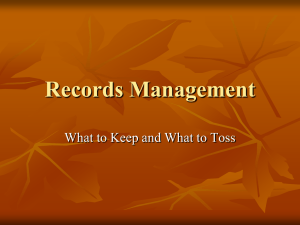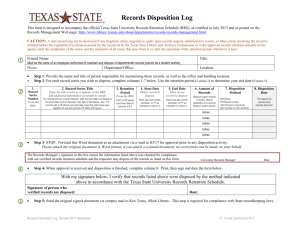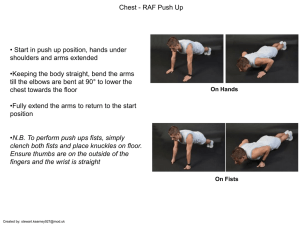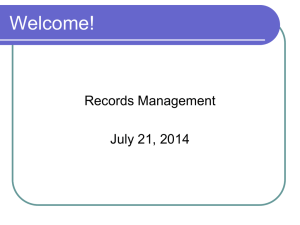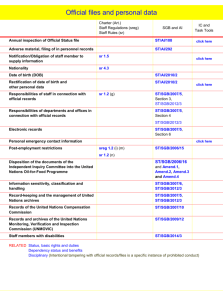Records Management Programme Evaluation Tool
advertisement
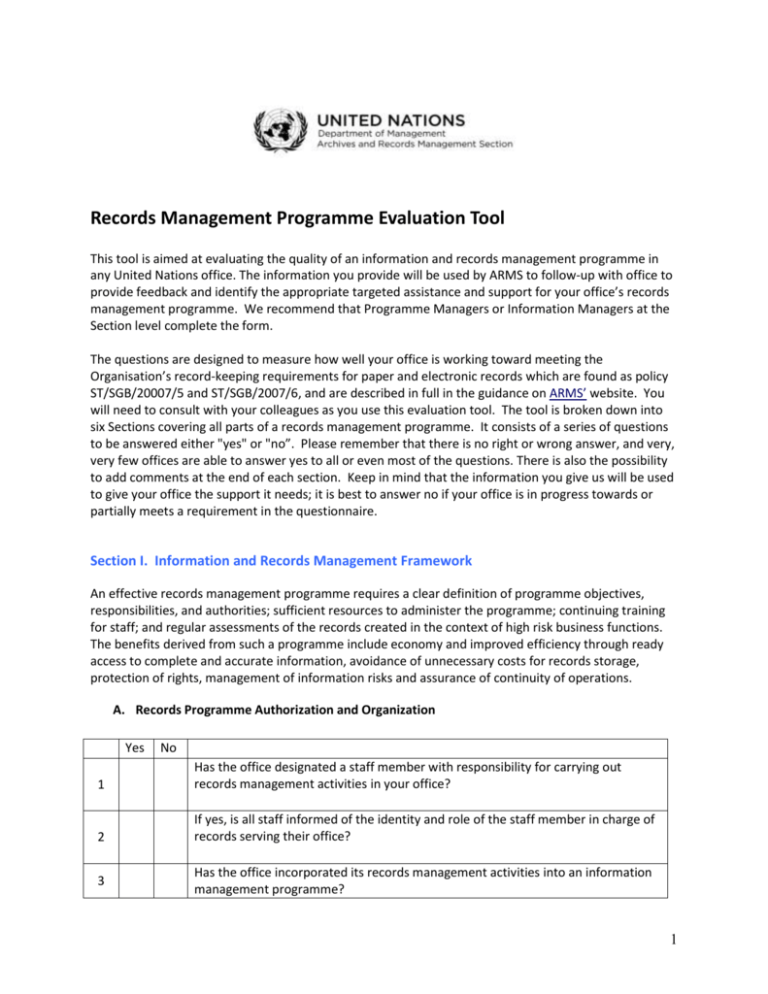
Records Management Programme Evaluation Tool This tool is aimed at evaluating the quality of an information and records management programme in any United Nations office. The information you provide will be used by ARMS to follow-up with office to provide feedback and identify the appropriate targeted assistance and support for your office’s records management programme. We recommend that Programme Managers or Information Managers at the Section level complete the form. The questions are designed to measure how well your office is working toward meeting the Organisation’s record-keeping requirements for paper and electronic records which are found as policy ST/SGB/20007/5 and ST/SGB/2007/6, and are described in full in the guidance on ARMS’ website. You will need to consult with your colleagues as you use this evaluation tool. The tool is broken down into six Sections covering all parts of a records management programme. It consists of a series of questions to be answered either "yes" or "no”. Please remember that there is no right or wrong answer, and very, very few offices are able to answer yes to all or even most of the questions. There is also the possibility to add comments at the end of each section. Keep in mind that the information you give us will be used to give your office the support it needs; it is best to answer no if your office is in progress towards or partially meets a requirement in the questionnaire. Section I. Information and Records Management Framework An effective records management programme requires a clear definition of programme objectives, responsibilities, and authorities; sufficient resources to administer the programme; continuing training for staff; and regular assessments of the records created in the context of high risk business functions. The benefits derived from such a programme include economy and improved efficiency through ready access to complete and accurate information, avoidance of unnecessary costs for records storage, protection of rights, management of information risks and assurance of continuity of operations. A. Records Programme Authorization and Organization Yes No 1 Has the office designated a staff member with responsibility for carrying out records management activities in your office? 2 If yes, is all staff informed of the identity and role of the staff member in charge of records serving their office? 3 Has the office incorporated its records management activities into an information management programme? 1 Is the staff member in charge of records involved in the development or deployment of electronic record-keeping systems or business information systems that contain records? Do records management practices, processes and staff resources in your office reflect the level of executive support outlined in the relevant bulletin, ST/SGB/2007/5, Section 4? 4 5 Comments B. Guidance and Training Yes 1 2 3 4 No Are briefing materials on records management best practice available to staff managing records in your office? Is your records management focal point(s) in contact with ARMS and is aware of the guidance, assistance, and records management policies, and procedures available on ARMS website? Have assistants and other staff with routine records management duties received training in records maintenance, filing procedures and records disposition (i.e. how long to keep, when and if to transfer to ARMS)? Has your records management focal point taken ARMS’ e-learning programme available on ARMS website? Comments 2 C. Risk Management Yes 1 No Has your office identified high risk business processes where the appropriate management of information and records is essential (e.g. management of confidential information, personal staff information, selected financial records etc.)? 2 Has the office assessed potential risks to the office's records? (e.g. technology change, sensitive content on the network, technology obsolescence) 3 Is the staff in your office sufficiently aware of ST/SGB/2007/6: Information sensitivity classification and handling? 4 Does the office use information security marking in accordance with Section 2 of ST/SGB/2007/6? This includes in electronic information systems. 5 Does the office have a business continuity and/or disaster management plan for its records and information? 6 Has the office identified its vital records (i.e. its emergency operating records and legal rights records) as part of its business continuity plan? 7 Has the office identified the risk of not capturing and managing information appropriately (e.g. legal/reputational risk)? Comments Section II. Records Creation and Capture Ensuring adequacy of documentation in any information system depends on the clear articulation of recordkeeping requirements. Record-keeping requirements specify the creation and maintenance of specific records to document office operations and activities; facilitate action by office officials and their successors; permit continuity and consistency in administration; protect the rights of the Organisation 3 and those affected by its actions; and document important meetings and the formulation and implementation of basic policy and decisions. Yes No Is staff in your office aware of guidance on the definition of United Nations records and non-record materials and the ways in which they must be managed? 1 Does your office use a file classification plan for electronic records? 2 Does your office use a file classification plan for paper records? 3 Comments Section III. Maintenance of Paper Records Proper management of records ensures that complete records are maintained; records can be located when needed; records, non-record materials, and personal papers are maintained separately; and the identification and retention of permanent records are facilitated. Proper records maintenance also contributes to economy of operations by facilitating records disposition. This Section covers general records maintenance policies and practices, regardless of media, and several aspects of records maintenance that apply to paper-based records. The next Section specifies additional requirements for special records, i.e., records other than traditional paper text. Yes 1 2 3 No Has the office established standards and procedures for classifying, indexing, filing, and retrieving records? Is access to all records, regardless of media, limited to authorized personnel? Has the office established and implemented regulations or procedures for the storage of security classified and other restricted records? 4 Comments Section IV. Maintenance of Electronic Records The following questions apply to all electronic information systems that contain United Nations records, regardless of media or application: Yes No 1 Are you aware that a portion of electronic information should be captured as records, and preserved as evidence of business? 2 Are all electronic records created by the office accessible to staff to conduct their daily work? (i.e. on UN information systems , UN networks) 3 Do electronic record-keeping systems require user identification codes or passwords to control access and ensure integrity of the documents? Comments Section V. Records Retention Schedule and Disposition The records disposition is the controlled process in which offices dispose of records that are no longer needed so only those active records needed for current business. As allowed by provisions in records retention schedules, offices may (securely) destroy records or transfer them to ARMS. The records disposition programme contributes to economical and efficient office operations. Disposition must be based on approved, up-to-date, and properly implemented comprehensive records schedules. The 5 Secretariat has a general records schedule for administrative records found in most offices and for nonrecord copies of your office records. See RCUN: Records common to all UN offices to manage the administrative and/or temporary records common to most offices. Each office must have an approved retention schedules for covering all functions of its operations. ARMS facilitates the approval of schedules for United Nations records in collaboration with stakeholders. No disposition actions should be taken unless according to an approved records retention schedule. Historical archives must be transferred to ARMS for preservation; consultations with ARMS are recommended for digital, multi-media and other records that are at risk because of their fragility or special preservation needs. Yes No Does the office have a retention schedule that covers all core operations and all records? Is your retention schedule up to date AND covers all electronic records? If your retention schedule used by all units, and familiar to all staff? Does your office use the Secretariat’s general retention schedules, for administrative and other records common to all UN offices (RCUN)? Are records destroyed only in accordance with ARMS-approved records schedules? Are permanent records transferred to ARMS for preservation? 1 2 3 4 5 6 Comments Section VI Access to Records Each office should ensure that its records remain accessible for as long as required to meet accountability, legal and business requirements. Records should have meaningful descriptive metadata so that they can be retrieved by staff to conduct their daily tasks, access and control mechanism should be established to ensure that access to the records should be based on the “need to know” while conducting UN business. Yes No 1 Is there a centralised filing system that allows staff to retrieve documents and record as needed to conduct their daily work? 2 Does the office control, log or track access to electronic and paper records? 6 3 4 Do you have systems in place to prevent unauthorised access to both paper and records? Are there procedures in place to ensure staff knows that records belong to the Organisation so that there should be no access to the records after staff leaves the office or separates from the Organization? Comments 7

